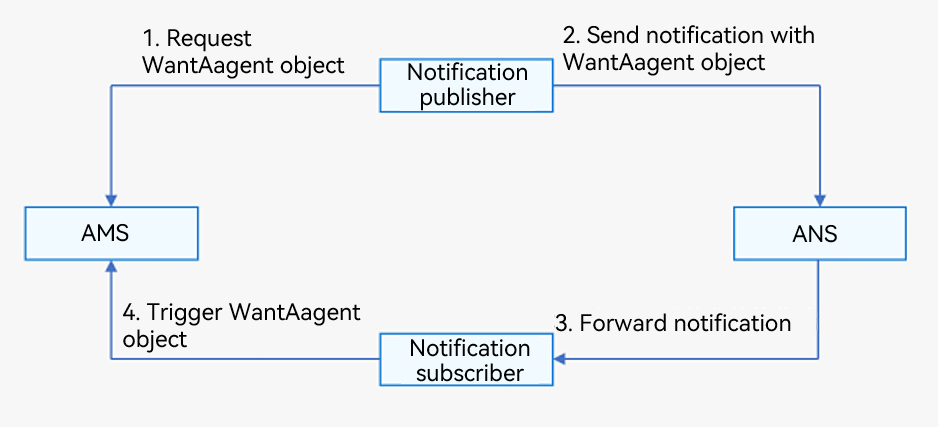Adding a WantAgent Object to a Notification
A WantAgent object encapsulates an intention to start a specified ability, release a common event, and more. A WantAgent object can be passed in a notification from the publisher to the subscriber, so as to trigger the intention specified. For example, you may want the user to start a specific ability by touching the notification published by your application. In this case, you can add a WantAgent object that encapsulates such an action to the notification. After receiving the WantAgent object, the system triggers it once the user touches the notification from the notification panel, starting the specified ability.
Below you can see the process of adding a WantAgent object to a notification. The notification publisher requests a WantAgent object from the Ability Manager Service (AMS), and then sends a notification carrying the WantAgent object to the home screen. When the user touches the notification from the notification panel on the home screen, the WantAgent object is triggered.
Figure 1 Publishing a notification with a WantAgent object

Available APIs
For details about the APIs, see @ohos.app.ability.wantAgent.
| Name | Description |
|---|---|
| getWantAgent(info: WantAgentInfo, callback: AsyncCallback<WantAgent>): void | Creates a WantAgent object. |
| trigger(agent: WantAgent, triggerInfo: TriggerInfo, callback?: Callback<CompleteData>): void | Triggers a WantAgent object. |
| cancel(agent: WantAgent, callback: AsyncCallback<void>): void | Cancels a WantAgent object. |
| getWant(agent: WantAgent, callback: AsyncCallback<Want>): void | Obtains a WantAgent object. |
| equal(agent: WantAgent, otherAgent: WantAgent, callback: AsyncCallback<boolean>): void | Checks whether two WantAgent objects are equal. |
How to Develop
-
Request notification authorization. Your application can send notifications only after obtaining user authorization.
-
Import the modules.
import notificationManager from '@ohos.notificationManager'; import wantAgent from '@ohos.app.ability.wantAgent'; import { WantAgent } from '@ohos.app.ability.wantAgent'; import Base from '@ohos.base'; -
Create a WantAgentInfo object.
Scenario 1: Create a WantAgentInfo object for starting a UIAbility component.
let wantAgentObj:WantAgent; // Save the created WantAgent object for completing the trigger operations at a later time. // Set the action type through operationType of WantAgentInfo. let wantAgentInfo:wantAgent.WantAgentInfo = { wants: [ { deviceId: '', bundleName: 'com.samples.notification', abilityName: 'SecondAbility', action: '', entities: [], uri: '', parameters: {} } ], operationType: wantAgent.OperationType.START_ABILITY, requestCode: 0, wantAgentFlags:[wantAgent.WantAgentFlags.CONSTANT_FLAG] };Scenario 2: Create a WantAgentInfo object for publishing a common event.
let wantAgentObj:WantAgent; // Save the created WantAgent object for completing the trigger operations at a later time. // Set the action type through operationType of WantAgentInfo. let wantAgentInfo:wantAgent.WantAgentInfo = { wants: [ { action: 'event_name', // Set the action name. parameters: {}, } ], operationType: wantAgent.OperationType.SEND_COMMON_EVENT, requestCode: 0, wantAgentFlags: [wantAgent.WantAgentFlags.CONSTANT_FLAG], }; -
Call the getWantAgent() API to create a WantAgent object.
// Create a WantAgent object. wantAgent.getWantAgent(wantAgentInfo, (err:Base.BusinessError, data:WantAgent) => { if (err) { console.error(`Failed to get want agent. Code is ${err.code}, message is ${err.message}`); return; } console.info('Succeeded in getting want agent.'); wantAgentObj = data; }); -
Create a NotificationRequest object and publish a notification that carries the WantAgent object.
// Create a NotificationRequest object. let notificationRequest: notificationManager.NotificationRequest = { content: { notificationContentType: notificationManager.ContentType.NOTIFICATION_CONTENT_BASIC_TEXT, normal: { title: 'Test_Title', text: 'Test_Text', additionalText: 'Test_AdditionalText', }, }, id: 6, label: 'TEST', wantAgent: wantAgentObj, } notificationManager.publish(notificationRequest, (err:Base.BusinessError) => { if (err) { console.error(`Failed to publish notification. Code is ${err.code}, message is ${err.message}`); return; } console.info('Succeeded in publishing notification.'); }); -
When the user touches the notification from the notification panel, the system automatically triggers the action specified in the WantAgent object.